Endpoint security is as important as identity governance and access management
Information security receives significant focus these days. Amid increase in cyber-attacks, notably on endpoints, there is an urgent need to build a secure and reliable IT framework.
Identity and Access Management (IAM) and cloud identity governance, several studies show, receive maximum IT security spending budgets. Fair enough, reinforcing identity governance optimizes IT resources.
However, the endpoint security is not very far away in the info-sec spending priority list. The sudden need to reinforce the endpoint security arises from the fact a large number of attacks originate from endpoints.
An abrupt surge in remote work environments and growing sophistication of endpoint attacks necessitates urgent need to protect endpoints. In previous articles, the focus therefore was on discussing some of the best concepts for optimizing the endpoint security.
How Endpoint security reinforces IAM initiatives?
a) Endpoint security mitigates data exfiltration and malicious applications threats
IAM and PAM initiatives enable IT security teams to enforce a policy-based access entitlement. These initiatives help to govern, control and audit every access to critical systems and applications. The purpose of IAM controls is to protect the data.
Nevertheless, not every application and every end-user are provisioned for role-based access. Those without elevated privileges could still use malicious applications running in the IT environment.
If such anomalous patterns went unnoticed, wouldn’t it be a threat to IT security? Of course, it will threaten DLP initiatives. Data could be misused or abused.
In the emerging context, endpoint security supports IAM and PAM initiatives by widening the security net to thwart data exfiltration. Examples include Application blacklisting, whitelisting and endpoint elevation on-demand.
b) Endpoint security provides behaviour analytics
In general, session management, password management, and reporting capabilities are seen as basic requirements to implement IAM/PAM controls. Nevertheless, one big security component missing here is the behaviour analytics.
Behaviour analytics on end-users reinforces IAM controls by raising alerts on those end-users (with or without privileges) that are potential threats to data. Let’s put this way, behaviour analytics, a critical component of endpoint security, mitigates the risk before it becomes a threat.
c) Endpoint security ensures robust compliance framework
IAM and PAM initiatives help to restrict and monitor the controlled access to systems. Ensuring authorized access to systems in turn helps to build a compliance framework. Nevertheless, one never knows if any piece of data is compromised, accidently or with intent. Against the backdrop of an increasing number of SaaS applications, there is a possibility of a data breach. SaaS applications are typically installed spontaneously and sometimes without centralized access policy.
With Endpoint Security measures such as just-in-time Privileged Elevation to all critical applications, organizations can build a robust compliance framework.
The bottom-line
Endpoint Security controls make IAM initiatives more effective. Therefore, Endpoint Security should be InfoSec tactical priority.

